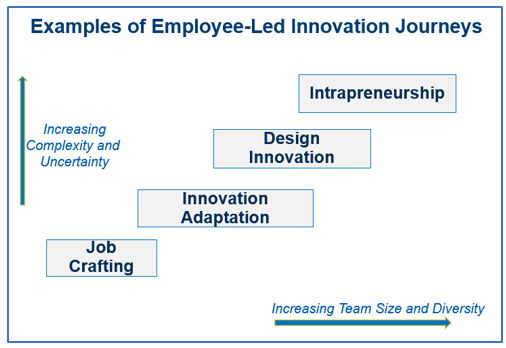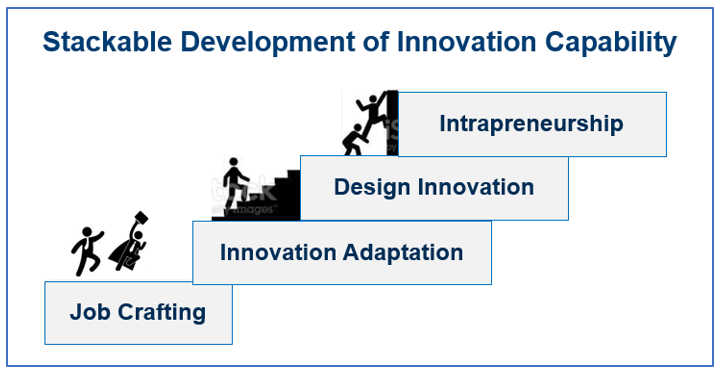Thomas Carey, Janet Zlotnik, Blake Melnick, Anahita Baregheh & Tyrenny Anderson
In our initiative on Workplace Innovation and Quality of Work Life, each of our four project partners is reaching out to their organizational networks with an offer of support in moving From Goals to Game Plans for employee-led workplace innovation. We pilot tested this approach last month in a session hosted by the Centre for Digital Transformation at B.C. Institute of Technology, and will shortly be following up in adaptations with the Newfoundland and Labrador Workforce Innovation Centre (Oct), Electricity Human Resources Canada (Nov) and our lead partner WEtech Alliance (Dec).
In this post, we’ll summarize the From Goals to Game Plan process to advance employee-led innovation in our partner organizations, which has emerged from the cases we have been working on with a set of initial representative workplaces. We’ll also illustrate our own use of such research insights and exemplary practices in developing this framework for two purposes:
as an organizing structure for our workshops to help partner workplaces to identify where and how they want to advance workplace innovation with their employees
and later as the organizing framework for two key outputs from the Workplace Innovation and Quality of Work Life project, a Research Adaptation Synthesis and its accompanying illustrative Case Stories from participating workplaces.
From Goals to Game Plans: Four Steps to Enhance Employee-led Workplace Innovation
Identify and Integrate Innovation Goals: Employee-led Workplace Innovation can improve Performance on your Organizational mission, enhance Quality of Work Life for Employees and address larger Social Goals (such as Sustainability or Diversity, Equity and Inclusion). For example, in Europe a growing body of evidence across sectors has demonstrated how integrating quality of work life into workplace Innovation plans can energize employee engagement across a broader range of job positions. (You can learn here about our new collaboration to test how we can adapt that evidence into Canadian workplace contexts.)
For example, the European initiative on Sustainable Work helps companies to integrate goals on sustaining the well-being of employees for work engagement over a longer career span, sustaining the well-being of the employing organizations and the jobs they create, and sustaining the health and well-being of our environment and our social goals.
Design Employee-led Innovation Journeys: There are multiple different opportunities for employees to engage in the social process of workplace innovation. Each of these has a different ‘innovation journey” social process, team roles, risks and results. Depending on your Goals, you may choose to enhance your current innovation journey processes or to initiate new innovation journeys (or both).
You can see an example of one organizational mapping of different innovation journeys in this diagram, which maps different opportunities for employee-led innovation processes as a progression with increasing uncertainty, complexity, team size and impacts. (And you can read more here about how this particular progression fit into our collaboration with a workplace partner whose priority goal was to engage a broader set of employees in workplace innovation.)
3. Develop Employee Capabilities: Enhancing employee capability to engage in workplace innovation may be a specific “pain point” results amongst workplace innovation Goals. In addition, new or enhanced Innovation Journeys will require additional employee capability to empower successful engagement. Your Game Plan for workplace innovation is therefore very likely to include actions to further develop employee capability.
For example, some of our workplace partners are now exploring how a progression of innovation journeys could be supported by a sequence of professional development steps which build on previous learning (in the spirit of “stackable” credentials). This allows each employee to determine their own level of engagement within the sequence, while also promoting an organization-wide culture of inclusive workplace innovation. We’ve been experimenting with these ideas in developing innovation capability with both higher education students and working learners
4. Align Organizational Capabilities: Employee Capability for workplace innovation is only one part of the Organizational Capability required for successful workplace innovation to create lasting value. The leading framework for this organization capability, the Fifth Element Model created and deployed by Workplace Innovation Europe, outlines three additional elements of Organizational Capability (as shown in the diagram below):
Job and Team structures which nurture and encourage workplace innovation
Management policies to support and recognize employee workplace innovation
Employee engagement in collaborative leadership and ownership of workplace innovation and an integrative ‘Fifth Element’ – pictured at the core of the diagram – to bring all these elements together into a cohesive innovation culture.
Research Adaptations in Support of this From Goals to Game Plans Process
Our development of the process outlined above –and of the workshops to help workplace partners engage with it – was supported by two key resources:
Pilot tests with Ontario workplaces who had already developed research-informed Innovation Journeys and Employee Capability, as “alumni” from the Innovation Catalyst program of our lead workplace partner, WEtech Alliance.
Adaptation of research insights and exemplary practices from our colleagues in Workplace Innovation Europe (facilitated by WINEU co-founder Peter Totterdill, a team member in our Workplace Innovation and Quality of Work Life project)
Here are some “we practice what we preach” examples of our adaptations of work from Europe (and elsewhere) to support both our project goals and our own Quality of Work Life as a team:
In an exemplary Learning Network of innovation projects in Swedish municipalities, we learned about the use of an Outcome-Process-Support structure which parallels our Goals-Journeys-Capabilities [Nählinder & Eriksson 2019].
From a Dutch research study on how human resource management supports ‘Bottom-Up’ workplace innovation, we adapted the image of employee innovation journeys moving from informal “pathways” into smoother, wider and faster innovation “routes” [Renkema et al 2021].
We also used ideas from Workplace Innovation – Europe’s Competitive Edge to target our WINCan work toward a complementary competitive edge for Canada. [Totterdill et al 2022]
Acknowledgements: Workplace Innovation and Quality of Work Life is supported in part by the Government of Canada’s Future Skills program. Special thanks go to the BCIT team who hosted and supported our successful pilot test of the ideas here: Steve Wilson, Director of the Centre for Digital Transformation; Janet Zlotnik, Project Manager; and Tom Roemer, Academic Vice-President (our executive Champion).
References:
Nählinder, J., & Eriksson, A. F. (2019). Outcome, process and support: analysing aspects of innovation in public sector organizations. Public Money & Management, 39(6), 443-449.
Renkema, M., Meijerink, J., & Bondarouk, T. (2021). Routes for employee-driven innovation: how HRM supports the emergence of innovation in a formalized context. The International Journal of Human Resource Management, 1-35.
Totterdill, P., Pot, F., Dhondt, S., & Warhurst, C. (2022). Workplace Innovation: Europe's Competitive Edge. European Journal of Workplace Innovation, 7(1), 132-141.
Author information is available on the WINCan Support Team page



